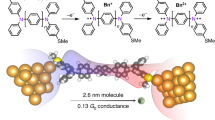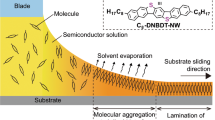Abstract
Large π-conjugated molecules, when in contact with a metal surface, usually retain a finite electronic gap and, in this sense, stay semiconducting. In some cases, however, the metallic character of the underlying substrate is seen to extend onto the first molecular layer. Here, we develop a chemical rationale for this intriguing phenomenon. In many reported instances, we find that the conjugation length of the organic semiconductors increases significantly through the bonding of specific substituents to the metal surface and through the concomitant rehybridization of the entire backbone structure. The molecules at the interface are thus converted into different chemical species with a strongly reduced electronic gap. This mechanism of surface-induced aromatic stabilization helps molecules to overcome competing phenomena that tend to keep the metal Fermi level between their frontier orbitals. Our findings aid in the design of stable precursors for metallic molecular monolayers, and thus enable new routes for the chemical engineering of metal surfaces.
This is a preview of subscription content, access via your institution
Access options
Subscribe to this journal
Receive 12 print issues and online access
$259.00 per year
only $21.58 per issue
Buy this article
- Purchase on Springer Link
- Instant access to full article PDF
Prices may be subject to local taxes which are calculated during checkout




Similar content being viewed by others
References
Netzer, F. P. & Ramsey, M. G. Structure and orientation of organic molecules on metal surfaces. Crit. Rev. Solid State 17, 397–475 (1992).
Ishii, H., Sugiyama, K., Ito, E. & Seki, K. Energy level alignment and interfacial electronic structures at organic/metal and organic/organic interfaces. Adv. Mater. 11, 605–625 (1999).
Braun, S., Salaneck, W. R. & Fahlman, M. Energy-level alignment at organic/metal and organic/organic interfaces. Adv. Mater. 21, 1450–1472 (2009).
Hwang, J., Wan, A. & Kahn, A. Energetics of metal–organic interfaces: new experiments and assessment of the field. Mater. Sci. Eng. Rep. 64, 1–31 (2009).
Koch, N. Organic electronic devices and their functional interfaces. Chem. Phys. Chem. 8, 1438–1455 (2007).
Hipps, K. W. Molecular electronics – it's all about contacts. Science 294, 536–537 (2001).
Glowatzki, H. et al. ‘Soft’ metallic contact to isolated C60 molecules. Nano Lett. 8, 3825–3829 (2008).
Jaeckel, B., Sambur, J. B. & Parkinson, B. A. The influence of metal work function on the barrier heights of metal/pentacene junctions. J. Appl. Phys. 103, 063719 (2008).
Koch, N. et al. Molecular orientation dependent energy levels at interfaces with pentacene and pentacenequinone. Org. Electron. 7, 537–545 (2006).
Koch, N., Vollmer, A., Duhm, S., Sakamoto, Y. & Suzuki, T. The effect of fluorination on pentacene/gold interface energetics and charge reorganization energy. Adv. Mater. 19, 112–116 (2007).
Koch, N. et al. Adsorption-induced intramolecular dipole: correlating molecular conformation and interface electronic structure. J. Am. Chem. Soc. 130, 7300–7304 (2008).
Crocker, L., Wang, T. B. & Kebarle, P. Electron-affinities of some polycyclic aromatic-hydrocarbons, obtained from electron-transfer equilibria. J. Am. Chem. Soc. 115, 7818–7822 (1993).
Delgado, M. C. R. et al. Impact of perfluorination on the charge-transport parameters of oligoacene crystals. J. Am. Chem. Soc. 131, 1502–1512 (2009).
Duhm, S. et al. Influence of intramolecular polar bonds on interface energetics in perfluoro-pentacene on Ag(111). Phys. Rev. B 81, 045418 (2010).
Hauschild, A. et al. Molecular distortions and chemical bonding of a large π-conjugated molecule on a metal surface. Phys. Rev. Lett. 94, 036106 (2005).
Rohlfing, M., Temirov, R. & Tautz, F. S. Adsorption structure and scanning tunneling data of a prototype organic–inorganic interface: PTCDA on Ag(111). Phys. Rev. B 76, 115421 (2007).
Tautz, F. S. Structure and bonding of large aromatic molecules on noble metal surfaces: the example of PTCDA. Prog. Surf. Sci. 82, 479–520 (2007).
Bendounan, A. et al. Electronic structure of 1 ML NTCDA/Ag(111) studied by photoemission spectroscopy. Surf. Sci. 601, 4013–4017 (2007).
Kilian, L. et al. Role of intermolecular interactions on the electronic and geometric structure of a large π-conjugated molecule adsorbed on a metal surface. Phys. Rev. Lett. 100, 136103 (2008).
Ziroff, J. et al. Low-energy scale excitations in the spectral function of organic monolayer systems. Phys. Rev. B 85, 161404 (2012).
Duhm, S. et al. PTCDA on Au(111), Ag(111) and Cu(111): correlation of interface charge transfer to bonding distance. Org. Electron. 9, 111–118 (2008).
Duhm, S. et al. Weak charge transfer between an acceptor molecule and metal surfaces enabling organic/metal energy level tuning. J. Phys. Chem. B 110, 21069–21072 (2006).
Koch, N. et al. Tuning the hole injection barrier height at organic/metal interfaces with (sub)monolayers of electron acceptor molecules. Appl. Phys. Lett. 87, 101905 (2005).
Koch, N., Duhm, S., Rabe, J. P., Vollmer, A. & Johnson, R. L. Optimized hole injection with strong electron acceptors at organic–metal interfaces. Phys. Rev. Lett. 95, 237601 (2005).
Romaner, L. et al. Impact of bidirectional charge transfer and molecular distortions on the electronic structure of a metal–organic interface. Phys. Rev. Lett. 99, 256801 (2007).
Rangger, G. M. et al. F4TCNQ on Cu, Ag, and Au as prototypical example for a strong organic acceptor on coinage metals. Phys. Rev. B 79, 165306 (2009).
Tseng, T. C. et al. Charge-transfer-induced structural rearrangements at both sides of organic/metal interfaces. Nature Chem. 2, 374–379 (2010).
Toyoda, K., Hamada, I., Lee, K., Yanagisawa, S. & Morikawa, Y. Density functional theoretical study of pentacene/noble metal interfaces with van der Waals corrections: vacuum level shifts and electronic structures. J. Chem. Phys. 132, 134703 (2010).
Toyoda, K., Hamada, I., Lee, K., Yanagisawa, S. & Morikawa, Y. Density functional theoretical study of perfluoropentacene/noble metal interfaces with van der Waals corrections: adsorption states and vacuum level shifts. J. Phys. Chem. C 115, 5767–5772 (2011).
Amy, F., Chan, C. & Kahn, A. Polarization at the gold/pentacene interface. Org. Electron. 6, 85–91 (2005).
Tsiper, E. V., Soos, Z. G., Gao, W. & Kahn, A. Electronic polarization at surfaces and thin films of organic molecular crystals: PTCDA. Chem. Phys. Lett. 360, 47–52 (2002).
Witte, G., Lukas, S., Bagus, P. S. & Wöll, C. Vacuum level alignment at organic/metal junctions: ‘cushion’ effect and the interface dipole. Appl. Phys. Lett. 87, 263502 (2005).
Medjanik, K. et al. Electronic structure of large disc-type donors and acceptors. Phys. Chem. Chem. Phys. 12, 7184–7193 (2010).
Bröker, B. et al. Gold work function reduction by 2.2 eV with an air-stable molecular donor layer. Appl. Phys. Lett. 93, 243303 (2008).
Hofmann, O. T., Rangger, G. M. & Zojer, E. Reducing the metal work function beyond Pauli pushback: a computational investigation of tetrathiafulvalene and viologen on coinage metal surfaces. J. Phys. Chem. C 112, 20357–20365 (2008).
Fernandez-Torrente, I. et al. Long-range repulsive interaction between molecules on a metal surface induced by charge transfer. Phys. Rev. Lett. 99, 176103 (2007).
Rissner, F. et al. Radical self-assembled monolayers on Au(111) formed by the adsorption of closed-shell molecules. J. Mater. Chem. 22, 4269–4272 (2012).
Zegenhagen, J. et al. X-ray standing waves and hard X-ray photoelectron spectroscopy at the insertion device beamline ID32. J. Electron Spectrosc. Relat. Phenom. 178, 258–267 (2010).
Woodruff, D. P. Surface structure determination using X-ray standing waves. Rep. Prog. Phys. 68, 743–798 (2005).
Zegenhagen, J. Surface-structure determination with X-ray standing waves. Surf. Sci. Rep. 18, 199–271 (1993).
Gerlach, A. et al. Adsorption-induced distortion of F16CuPc on Cu(111) and Ag(111): an X-ray standing wave study. Phys. Rev. B 71, 205425 (2005).
Gerlach, A. et al. Orientational ordering of nonplanar phthalocyanines on Cu(111): strength and orientation of the electric dipole moment. Phys. Rev. Lett. 106, 156102 (2011).
Henze, S. K. M., Bauer, O., Lee, T. L., Sokolowski, M. & Tautz, F. S. Vertical bonding distances of PTCDA on Au(111) and Ag(111): relation to the bonding type. Surf. Sci. 601, 1566–1573 (2007).
Kresse, G. & Furthmüller, J. Efficiency of ab-initio total energy calculations for metals and semiconductors using a plane-wave basis set. Comp. Mater. Sci. 6, 15–50 (1996).
Kresse, G. & Joubert, D. From ultrasoft pseudopotentials to the projector augmented-wave method. Phys. Rev. B 59, 1758–1775 (1999).
Perdew, J. P., Burke, K. & Ernzerhof, M. Generalized gradient approximation made simple. Phys. Rev. Lett. 77, 3865–3868 (1996).
Grimme, S. Semiempirical GGA-type density functional constructed with a long-range dispersion correction. J. Comput. Chem. 27, 1787–1799 (2006).
Ruiz, V. G., Liu, W., Zojer, E., Scheffler, M. & Tkatchenko, A. Density-functional theory with screened van der Waals interactions for the modeling of hybrid inorganic–organic systems. Phys. Rev. Lett. 108, 146103 (2012).
Heyd, J., Scuseria, G. E. & Ernzerhof, M. Hybrid functionals based on a screened Coulomb potential. J. Chem. Phys. 124, 219906 (2006).
Biller, A., Tamblyn, I., Neaton, J. B. & Kronik, L. Electronic level alignment at a metal–molecule interface from a short-range hybrid functional. J. Chem. Phys. 135, 164706 (2011).
Acknowledgements
The authors thank S. Hecht and Q. Xin for critically reading the manuscript, E. Zojer for fruitful discussions and O. T. Hofmann for providing the van der Waals parameters of gold. This work was supported by the Global Centres of Excellence Program of the Ministry of Education, Culture, Sports, Science and Technology (G03: Advanced School for Organic Electronics, Chiba University), and by the German Research Foundation through projects FR2726/1, SFB658, SFB951, SPP1355 and SCHR700/14-1. T.H. gratefully acknowledges an Alexander von Humboldt fellowship for foreign researchers.
Author information
Authors and Affiliations
Contributions
G.H., S.D., I.S., C.B., S.W., A.W., R.S., J.F., B.B. and A.V. performed the XPS and UPS measurements and pre-processed the data. With A.G. leading the efforts, S.D., J.N., C.B., T.H. and B.D. performed NIXSW experiments and analysed the data. A.S., I.F-T. and G.S. performed the scanning tunnelling microscopy measurements under the guidance of K.J.F. and J.I.P. J.P. provided the purified materials. I.S. analysed the XPS and UPS data and prepared the figures. With significant input from S.K. and N.U., G.H. and S.D. interpreted the overall results. G.H. performed the calculations, coordinated the work and wrote the paper. A.G., F.S. and N.K. conceived the project and all the authors commented critically on the manuscript.
Corresponding authors
Ethics declarations
Competing interests
The authors declare no competing financial interests.
Supplementary information
Supplementary information
Supplementary information (PDF 6045 kb)
Rights and permissions
About this article
Cite this article
Heimel, G., Duhm, S., Salzmann, I. et al. Charged and metallic molecular monolayers through surface-induced aromatic stabilization. Nature Chem 5, 187–194 (2013). https://doi.org/10.1038/nchem.1572
Received:
Accepted:
Published:
Issue Date:
DOI: https://doi.org/10.1038/nchem.1572
This article is cited by
-
Tetrathiafulvalenes as anchors for building highly conductive and mechanically tunable molecular junctions
Nature Communications (2022)
-
Electronic structures and optical characteristics of fluorescent pyrazinoquinoxaline assemblies and Au interfaces
Scientific Reports (2021)
-
Electrostatic control over temperature-dependent tunnelling across a single-molecule junction
Nature Communications (2016)
-
Chemical principles of single-molecule electronics
Nature Reviews Materials (2016)
-
Quasi one-dimensional band dispersion and surface metallization in long-range ordered polymeric wires
Nature Communications (2016)



